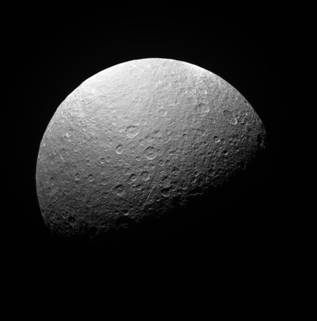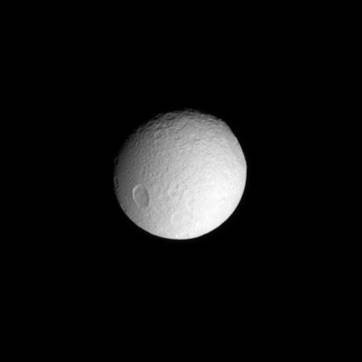16 June 2008

Fig (1)
Rhea, Saturn’s second largest moon
Credit: NASA/JPL/Space Science Institute
NASA’s Jet Propulsion Laboratory (JPL) recently published wonderful ultraviolet images of two of Saturn’s icy moons; Rhea (1,528 km across), Saturn’s second largest moon, and Tethys (1,062 km across), Saturn’s enigmatic icy moon. The images were acquired by the Saturn-bound Cassini spacecraft.
Fig (1) shows Rhea. Cassini flybys have revealed that Rhea appears to be composed of approximately 75% ices and 25% rock and metal.
The image was taken with the Cassini spacecraft narrow-angle camera on 12 April 2008, using an ultraviolet filter. The view was acquired at a distance of approximately 345,000 km from Rhea. Image scale is 2 km per pixel.
Rhea orbits Saturn at an average distance of approximately 527,000 km, every 4.5 days! Our Moon (3,476 km across), orbits Earth at an average distance of approximately 384,000 km, every 27.3 days. In Greek mythology, Rhea was a wife of Cronus (Saturn), and a mother of Zeus (Jupiter), Poseidon (Neptune) and Hades (Pluto).

Fig (2)
Tethys, Saturn’s enigmatic icy moon
Credit: NASA/JPL/Space Science Institute
Fig (2) shows the anti-Saturn side of Tethys. North is toward the top of the picture. The enormous impact crater Odysseus (about 400 km across) is visible on the eastern limb of Tethys.
The image was taken with the Cassini spacecraft narrow-angle camera on 14 April 2008, using an ultraviolet filter. The spacecraft was approximately 1.1 million km from Tethys. Image scale is 7 km per pixel.
Tethys orbits Saturn in a circular orbit whose radius is approximately 295,000 km. The orbital period is only 1.9 days.
In Greek mythology, Tethys (a sea goddess) was a sister of Saturn and a wife of Oceanus.
Further Reading
Cassini-Huygens Mission to Saturn
http://saturn.jpl.nasa.gov/
NSSDC Planetary Data
http://nssdc.gsfc.nasa.gov/planetary/
The Eight Planets
http://www.nineplanets.org/
Aymen Mohamed Ibrahem
Senior Astronomy Specialist